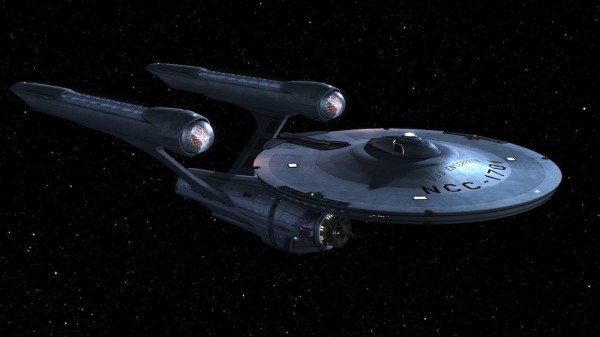When our science fiction fills our heads with ideas that could make our lives tremendously improved, we like to believe it's only a matter of time before technology catches up with our imaginations. Indeed, tricorders, wireless communicators and rocket ships were just some of the breakthroughs predicted by sci-fi on their way to becoming commonplace technology.
But many of our dreams are a long way from becoming reality, including human-sized teleporters, wormholes and time travel. What happens when science fiction runs into the cold, hard wall that is scientific reality?
Find out -- courtesy of Brian Koberlein -- over on the main Starts With A Bang blog.
- Log in to post comments



We could have a limited sort of hoverboard, that works with magnetic fields. It could only hover over special surfaces (very good conductors, or perhaps even high strength mag field coils). But of course the ground feels the force anyway.
I don't see how an information only time loop is excluded. It takes the work out of discovery no-one had to beat their head against the wall to figure it out. But this isn't all that different from making an important discovery by dumb luck and guessing a solution that can then be verified and applied. So I don't think causality may apply to intellectual content.
The ever-popular science fiction theme of a time machine has one serious flaw (among likely many others). Spatial dislocation following temporal relocation is always conveniently ignored, yet it's consideration is paramount. Accounting for extragalactic frames of reference, the displacement would amount to hundreds of kilometers in less than a second.
That displacement is a result of a combination of ceaseless high-velocity vectors:
Earth's rotation -- 815.00 mph (at my latitude)
Earth orbital velocity -- 66,611 mph (about the Sun)
Solar system velocity -- 492,125 mph (about the Milky Way)
Milky Way velocity --- 1,234,786 mph (relative to CMB)
Any successful time travel with the intent to end up at the same terrestrial location you departed from would require an enclosure with near warp-speed travel capability as a primary consideration, not to mention the travel required. Whether you're going forward or backward, you'll be far, far from home.
Warp-drive, implying faster-than-light travel, also has a particular problem that is never mentioned.
If I remember correctly, the Star Trek Technical Manual's did contain an analogy of surfing on a "warped space" wavefront which explained the ability to achieve superluminal speed without requiring infinite energy.
Okay. That's not the problem, And for the sake of my love of Star Trek, I'll buy into that. But because C is also the speed limit for the charge carrier of the electromagnetic field itself, atoms moving at that speed relative to the field could not coherently exist.
IIRC Kip Thorne pointed out that the grandmother paradox can be put together without any intelligent agents at all, just with particles. A particle goes through a wormhole, interacts with the earlier version of itself, changes it's course, preventing it from going through the wormhole.
Another problem is feedback. What if some photons go through a wormhole, find the entrance again, go through again...again...and again. It would be just like speaker-mircophone feedback, but given that its photons...boom. Big badaboom.
However, the grandmother paradox, the feedback problems, and all other similar time travel issues can be completely avoided if said wormhole's two ends are not in the same "observable universe" part of the universe. I.e., if space is expanding between the two ends faster than the speed of light, there are no causality problems.
So, ironically, it may be more feasible (in a theoretical sense; it's all ridiculously unrealistic) to travel instantaneously via wormhole to a planet very far away, than it would be to travel instantaneously via wormhole to a planet closer to us.
@Omega Centauri #1: Technically, there is no such thing as "information only." Information transfer requires energy (and causes a change of entropy). Even a space-like (that's the technical term for "back in time" in someone's frame) communication channel involves classical causality violation.
@eric #4: You're quire right about Kip's presentation of the non-agent grandfather paradox. It's been analyzed in quite wonderful detail since 1988. The current consensus is that you can analyze a temporal loop quantum mechanically, using an appropriate version of Feynman's sum over histories method.
In that case, what appears to happen is that only those "histories" which represent self-consistent closed paths contribute constructively to the wavefunction; histories involving "paradoxical" paths like you describe interfere destructively and "disappear." This essentially implements in a natural way the "temporal protection clause" of cosmic censorship :-)
Ahh.. the hoverboard :) Someone must have watched Big Bang Theory couple of weeks ago :)))
@ MandoZink #3
I can live with warp drive, even if it's slightly impossible :) At least the principles it relies on, as you have said, are supported (to an extent) by physics.
What has always bugged me in star trek... same is almost in all sci-fi even though I'm a a huge fan :).. is instantenous communication. In ST it's a sub-space field, but in general, in all sci-fi, communication is instant. Having a skype chat from one corner of galaxy to another is IMO a much greater "leap of faith" than any time machine or warp drive :)
Your statement "...where the helicopter blades push down on the air to keep the helicopter up" is actually not what keeps the craft in the air. The rotor of the helicopter act the same as a wing on an airplane only instead of traveling in a straight line the the plane flies, the "wings" of the rotor travel in a circle providing lift.
MandoZink, EE Smith's Lensman series dealt with it quite neatly by proposing that inertial mass was negotiable and if you removed it, you'd be able to move super-luminally, but when you turned off the effect, your original vector would be preserved.
Pancake city if you're planetbound at that point...
Some of the science is amusing because they were "logical extensions" of their current science. Tape loops being wires encoding the data, rather than magnetic or optical domains we'd use today for "science magic" data storage.
Go Cubs.
http://www.cnet.com/videos/taking-a-spin-on-a-real-life-hoverhoard/
Ah, I got ya. Yeah I can see that. IIRC from Feynman's "pieces" (can't remember whether it was the easy ones or the not-so-easy ones), he points out that in the 2-slit experiment it's a mistake to think the particle travels through both...it travels every concievable path through the universe. It's just that all the other paths cancel out, leaving those two as the only important ones for calculating the result. I can see the exact same sort of logic here: particle travels all paths (including the ones through the wormhole), but only a few don't cancel out and thus matter for calculating the result.
Ehy, I want one, too! May I? How much for it?....awww the whole reality, you said?....okay, that's really too much, nevermind. I will go for something more affordable, like Christmas' magic bag, or might be Aladdin 's Lamp....
;)
@Michael Motal #8
As a young child, I loved playing with the waterhose. One 'effect' I had noticed was that if I unscrewed the sprayhead leaving the more laminar 'jet' and bring it close to the smooth concrete patio then it would strongly repell until it was right down on it; At that point, It would 'suck' down and stick with the water streaming out in all directions radially and perpendicular to the outlet. This perplexed me (Bernoulli??).
I have often wondered if this 'effect' may form the basis of a craft where the water is pumped similarly along a disk or cone (to be collected at the edges) as a basis for lift. Either that, or a 'wing' comprised of a fast-moving, closed loop/belt exposed only on top of the 'wing'. -- In other words, the surface of the wing is still moving relative to the air.
@William Hendrixson #10 and Omega Centauri #1: Ask and ye shall receive. The Hendo hoverborad is exactly what Omega guessed: it uses conventional magnets to work against a conductive (copper plate) surface, essentially the same way a maglev train operates.
@ #10
that's a hell of a lot of copper to get around on. Might be useful in a factory, or storage facility; but steering 'might' be a problem. Safety? Uh oh.
Good luck and congratulations to ESA for their successful landing on comet 67P/Churyumov-Gerasimenko !! Wishful thinking followthrough .....
Not as depicted in the movie but still kind of neat:
https://www.kickstarter.com/projects/142464853/hendo-hoverboards-worlds…
@Anders #18: Please see comment #10 and followups. That's what is being discussed.
What? No eddie current damping?
Try this superconducting one on a Mobius strip --
https://www.youtube.com/watch?v=zPqEEZa2Gis
Try it with a chilly friend
https://www.youtube.com/watch?v=Zqmdv5iyIOY